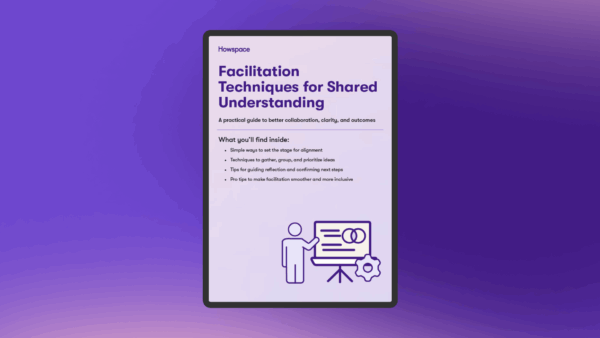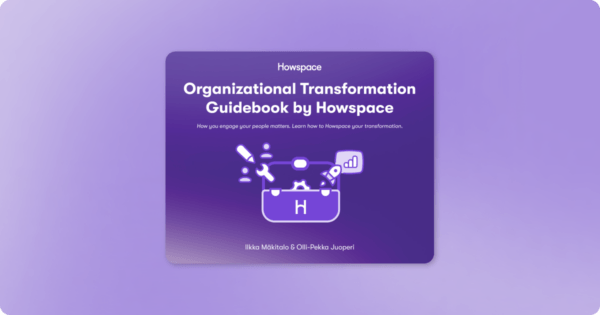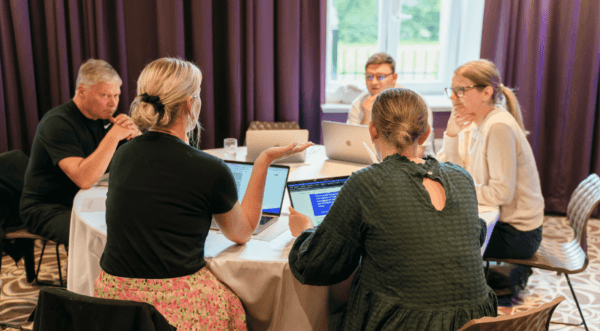
How to facilitate a workshop in 18 simple steps
If you want to learn how to facilitate a workshop effectively, you need to have the right skills and methods for different situations. The goal is to guide participants through a process of co-creation and active dialogue to achieve a specific objective together.
Facilitating a workshop can be challenging, but even inexperienced facilitators can achieve great results by following these 18 simple steps. These steps are designed to help you guide participants without controlling or managing them throughout the workshop. So, if you’re looking for practical advice on how to facilitate a workshop successfully, keep reading.
From workshop preparation to post-workshop engagement – here is the process in brief, which will be opened up further down below:
- Get to know the participants
- Define the purpose
- Set a clear goal
- Plan for more than just a day
- Prepare for the unexpected
- Set the scene
- Complete a check-in
- Go over the ground rules
- Share the agenda and set expectations
- Build trust with an icebreaker
- Facilitate, don’t control
- Encourage (multimedia) documentation
- Assess goal completion
- Complete check-out
- Communicate the next steps
- Paint the big picture and communicate progress
- Activate and engage
- Ask for feedback
The steps are also grouped into the three essential stages of a workshop: before, during, and after. Ultimately, you’ll learn what to take into account in workshop preparations and how to create and structure a successful workshop at each stage of its development and beyond. You can apply these steps whether your workshop is in-person, virtual, or hybrid (a mix of both).
Before the workshop
If you’re wondering how to facilitate a workshop, preparation is key. Going into a workshop unprepared is like stepping into a puddle with your socks on – you’ll end up with cold feet and regret. As a facilitator, your first step should be to carefully prepare to ensure success.
1. Get to know the participants
Whether you’re acting as an external consultant or organizing an in-house workshop, the very first thing you should do is to focus on the people. Try to understand who the participants are, what their group dynamic is like, and how you can best match the workshop to their knowledge.
2. Define the purpose
Once you understand who will be attending the workshop, it’s time to roll up your sleeves and make sure that you have a crystal clear idea of its purpose. Regardless of whose idea it was to organize the workshop in the first place, it’s good to get together with some key stakeholders at this point to make sure that everyone’s on the same page about what you’re trying to achieve. Only when you feel confident that everyone has a shared set of expectations can you move on to the next steps.
3. Set a clear goal
While getting everyone on the same page is a good start, you’ll also want to be able to measure the success of the workshop afterwards. However, the goal doesn’t have to be numeric or even a binary “yes or no” type of question. Instead, anything that you can track and follow up on will do, just as long as the group has a shared understanding of the target and can agree on whether or not it has been reached afterwards.
4. Plan for more than just the day
At Howspace, we’re always talking about “working beyond workshops.” In fact, we often look at workshops as three-week processes, rather than one-off occurrences.
That’s why it’s important to plan the entire process ahead of time. After all, a workshop is rarely just a workshop. In fact, it’s often the beginning or intervention for something that needs to happen in the participants’ day-to-day work. So, make sure to plan not just the workshop but also what will happen before and after it.
Some good questions to ask yourself in the planning phase include:
- What kinds of exercises and methods are best suited for the task at hand?
- Have I taken different people’s needs into consideration?
- Is there enough time for every element?
- How can I activate the participants before the physical meeting?
- What do I want the participants to leave with? What should the participants do afterwards?
- What kind of room and environment would best suit the group’s needs?
- Will we need any tools, equipment, or materials?
5. Prepare for the unexpected
With a clear plan of action in mind, it’s time to be brutally honest with yourself. Because even with the best-laid plans, the workshop might take a completely different turn from what you may have expected.
But that’s okay. Just remember that what you have planned may not be what the workshop participants need the most, and when that’s the case, you’re better off staying open to their needs. Because as our CEO Ilkka likes to say, openness, honesty, and authenticity are the most important qualities of a skilled facilitator.
During the workshop
Now that the workshop preparations are over, it’s time to have some fun. Remember to get a good night’s sleep the night before the workshop because as a workshop facilitator, you’re going to need all the energy and focus you can get.
6. Set the scene
Before the workshop participants arrive at the venue, you can do a lot to create the kind of atmosphere you want. Do you want people to feel calm, energetic, or relaxed? Think about how the room is set up (even if it will be virtual), how the furniture is organized, and even what kind of music you’ll have playing in the background. It’s the little things that will make all the difference.
7. Complete a check-in
Once everybody is settled in, it’s time to go around the room and complete check-in. This is a chance for the participants to share what they’re bringing to the table today, what they’re feeling right now, and what kind of mood they’re in. Are they excited about the workshop or did they have a terrible time dropping off their kids in the morning? You’ll never know unless you ask.
8. Go over the ground rules
Boring, I know—but as the workshop facilitator you’ll want to take a moment at the beginning to set some ground rules and go over the logistics: Where the bathrooms are, what time there’ll be breaks, and what the rules of engagement are during the day will be.
However, it’s also important to note that the rules of engagement shouldn’t just be limited to the physical environment. Instead, we should adopt the same approach to each other regardless of whether we’re interacting in person or through a digital platform. And by making it obvious that the same rules will apply even after the workshop, it’ll be much easier to get engagement in the digital world.
Once the lower levels of Maslow’s hierarchy of needs have been taken care of, the workshop participants will be able to focus on more important things.
9. Share the agenda and set expectations
Before kicking off the first real exercise, it’s good to walk through the agenda together with the participants. Remember to also share the purpose and goal of the workshop, so that they’ll be able to recognize whether or not their discussions throughout the day will help you achieve the shared goal.
Make sure to also remind the participants that the work doesn’t end when the workshop ends. Set realistic expectations and make sure that everyone in the room knows what’s expected of them going forward.
10. Build trust with an icebreaker
Especially if the participants are unfamiliar with each other, it’s a good idea to take some time at the beginning of the day to build trust and share some personal information or anecdotes. An icebreaker like this may seem silly, but the lighter mood you’ll get as a result will be worth all the awkwardness. To get the discussions going, it’s always good to start talking about something you know. And the easiest way to do that is through personal introductions since people love talking about themselves.
11. Facilitate, don’t control
As the workshop facilitator, it is your job to lead the discussion without taking part in it. You’ll have to make sure that people stay on topic for the most part but you’ll also want to keep an open mind about unexpected topics, as they may actually prove to be really valuable.
Throughout the day, make sure that all the participants are seen and heard. Try alternating with different kinds of methods and exercises to create a balanced agenda that will support the participants’ varying strengths.
12. Encourage (multimedia) documentation
Traditionally, the workshop facilitator would be in charge of documenting the findings from the workshop. However, the problem with this approach is that the ownership of what’s been said and done during the day will move from the group to the facilitator. Not only does that reduce participant commitment but it also increases the odds of misinterpretation. Instead, you should encourage the participants to document progress in their own personal style.
Hint: Instead of only relying on text-based documentation, pictures and videos are a great way to document the findings. Audiovisual evidence of the surroundings will help the participants connect with their tasks afterwards.
13. Assess goal completion
Before you turn off the lights and let everyone go home, it’s time to get back to your yes or no question: Did you or did you not achieve the goal you’d set for the workshops? If the answer is yes, well done! And if it’s a no, make sure that you understand why the goal was not reached and whether you can or even should still aim to get there.
14. Complete check-out
When the workshop is nearing its end, it’s time for the participants to check out. Once again, go around the room and have everyone share what they’re taking with them, what they’ve learned, or what they’re going to do next.
15. Communicate the next steps
The one last thing that you’ll want to do is to remind everyone what’s expected of them after the workshop. Make sure that all the participants have a clear understanding of their next steps, and that they know how their tasks play into the bigger picture.
After the workshop
Step 1: Pat yourself on the back! Workshops can be quite intense, but after you’ve had some time to rest and re-energize, it’s time to pick up where you left off and carry on with the process.
16. Paint the big picture and communicate progress
After the workshop, the participants should understand two things: 1) the big picture, and 2) their role in getting there. As a workshop facilitator, you can reach out to the participants and try to gauge whether or not they know what they’re doing next and why they’re doing it. By making sure that every single one of the participants has anchored some personal meaning to the process, you’re likely to see much better results.
17. Activate and engage
At the beginning of this article, I advised you to think of the workshop as a three-week process. And now that the intensive, social phase of the process is over, you’ll want to follow up with your original plan and keep people engaged by sending them reminders and mini-activations that help them stay focused. And remember: this part is crucial because it’s where most of the actual work happens.
18. Ask for feedback
While others would advise you to ask for feedback immediately after the workshop, I find it more useful for everyone to ask it once the whole process is coming to its end. That way, the participants will have had time to reflect upon how everything has tied together, and they’ll be in a better position to judge whether or not the process has been successful.
Free guides
View all
Facilitation techniques for shared understanding
Simple, practical techniques to help groups align around ideas, clarify goals, and make collective progress — even in complex settings.

AI prompt cheatsheet
Use these AI prompts to speed up your workshop planning, design engaging activities, and make sense of participant input — without starting from scratch. Whether you’re using ChatGPT or another tool, let AI take care of the heavy lifting so you can focus on what really matters.

Organizational Transformation Guidebook
This guidebook, written by Ilkka Mäkitalo and Olli-Pekka Juoperi, explores how engagement drives successful transformations.
Events
View all
Webinar: How Unions 21 is future-proofing trade unions through AI and learning
Discover how Unions 21 uses AI and collaborative learning to strengthen union resilience and engagement.

Webinar: How Roffey Park Made Executive Learning Collaborative & Measurable
Learn how Roffey Park Institute improved their Executive Education offerings by making them more collaborative and measurable.

Webinar: Measuring Learning Impact
Join our interactive webinar to gain actionable insights on tracking learning success and proving impact.
Customer stories
View all
Stronger culture and better business results with Howspace
Discover how HomeMaid transformed its culture and business results with Howspace, boosting employee engagement and reducing turnover significantly.

AI-driven stakeholder collaboration: How Walmart built a community of policy-makers
Explore Walmart’s innovative approach to stakeholder collaboration using AI. See how PolicyLab enhances engagement and policy development through interactive platforms.

Leading trade union innovation and learning: How Unions 21 enables unions to claim their agency
Discover how Unions 21 empowers trade unions through inclusive, engaging online learning with Howspace—helping them stay connected, adapt to change, and lead renewal across the movement.